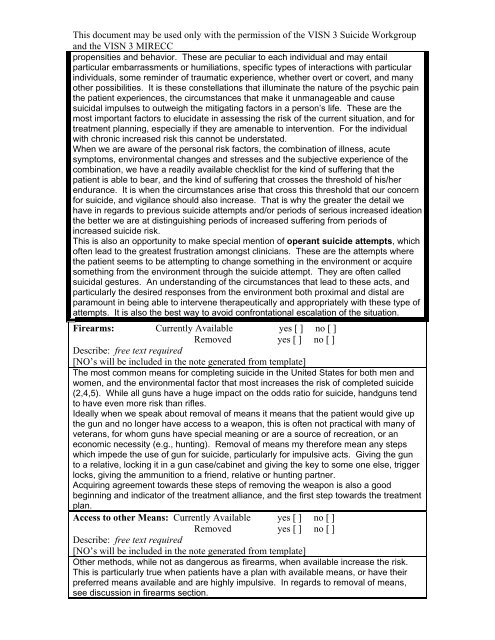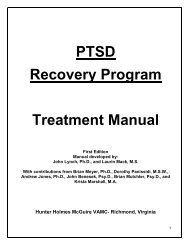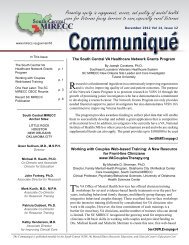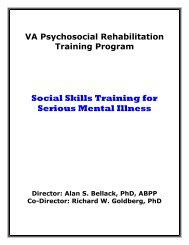Suicide Risk Assessment Package (VISN 3 MIRECC, US ...
Suicide Risk Assessment Package (VISN 3 MIRECC, US ...
Suicide Risk Assessment Package (VISN 3 MIRECC, US ...
Create successful ePaper yourself
Turn your PDF publications into a flip-book with our unique Google optimized e-Paper software.
This document may be used only with the permission of the <strong>VISN</strong> 3 <strong>Suicide</strong> Workgroup<br />
and the <strong>VISN</strong> 3 <strong>MIRECC</strong><br />
propensities and behavior. These are peculiar to each individual and may entail<br />
particular embarrassments or humiliations, specific types of interactions with particular<br />
individuals, some reminder of traumatic experience, whether overt or covert, and many<br />
other possibilities. It is these constellations that illuminate the nature of the psychic pain<br />
the patient experiences, the circumstances that make it unmanageable and cause<br />
suicidal impulses to outweigh the mitigating factors in a person’s life. These are the<br />
most important factors to elucidate in assessing the risk of the current situation, and for<br />
treatment planning, especially if they are amenable to intervention. For the individual<br />
with chronic increased risk this cannot be understated.<br />
When we are aware of the personal risk factors, the combination of illness, acute<br />
symptoms, environmental changes and stresses and the subjective experience of the<br />
combination, we have a readily available checklist for the kind of suffering that the<br />
patient is able to bear, and the kind of suffering that crosses the threshold of his/her<br />
endurance. It is when the circumstances arise that cross this threshold that our concern<br />
for suicide, and vigilance should also increase. That is why the greater the detail we<br />
have in regards to previous suicide attempts and/or periods of serious increased ideation<br />
the better we are at distinguishing periods of increased suffering from periods of<br />
increased suicide risk.<br />
This is also an opportunity to make special mention of operant suicide attempts, which<br />
often lead to the greatest frustration amongst clinicians. These are the attempts where<br />
the patient seems to be attempting to change something in the environment or acquire<br />
something from the environment through the suicide attempt. They are often called<br />
suicidal gestures. An understanding of the circumstances that lead to these acts, and<br />
particularly the desired responses from the environment both proximal and distal are<br />
paramount in being able to intervene therapeutically and appropriately with these type of<br />
attempts. It is also the best way to avoid confrontational escalation of the situation.<br />
Firearms: Currently Available yes [ ] no [ ]<br />
Removed yes [ ] no [ ]<br />
Describe: free text required<br />
[NO’s will be included in the note generated from template]<br />
The most common means for completing suicide in the United States for both men and<br />
women, and the environmental factor that most increases the risk of completed suicide<br />
(2,4,5). While all guns have a huge impact on the odds ratio for suicide, handguns tend<br />
to have even more risk than rifles.<br />
Ideally when we speak about removal of means it means that the patient would give up<br />
the gun and no longer have access to a weapon, this is often not practical with many of<br />
veterans, for whom guns have special meaning or are a source of recreation, or an<br />
economic necessity (e.g., hunting). Removal of means my therefore mean any steps<br />
which impede the use of gun for suicide, particularly for impulsive acts. Giving the gun<br />
to a relative, locking it in a gun case/cabinet and giving the key to some one else, trigger<br />
locks, giving the ammunition to a friend, relative or hunting partner.<br />
Acquiring agreement towards these steps of removing the weapon is also a good<br />
beginning and indicator of the treatment alliance, and the first step towards the treatment<br />
plan.<br />
Access to other Means: Currently Available yes [ ] no [ ]<br />
Removed yes [ ] no [ ]<br />
Describe: free text required<br />
[NO’s will be included in the note generated from template]<br />
Other methods, while not as dangerous as firearms, when available increase the risk.<br />
This is particularly true when patients have a plan with available means, or have their<br />
preferred means available and are highly impulsive. In regards to removal of means,<br />
see discussion in firearms section.






